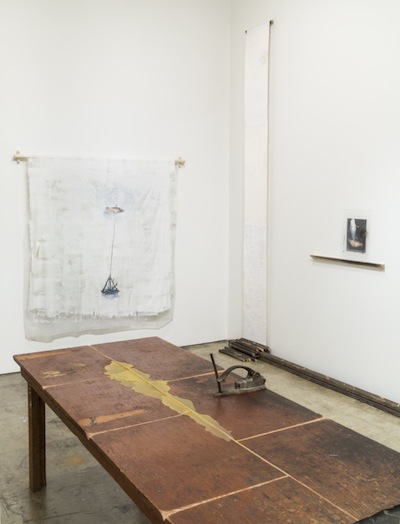Ed Fraga, “Tabula Rasa”
Re:View Contemporary
444 W. Willis, #112, Detroit, MI
October 25 – November 29, 2014
What’s on view: The gallery, which is separated into two exhibition spaces, contains a series of Fraga’s amorphous, figurative paintings on crinkly found paper in one space, while in the other, his collection of altered found objects and materials forms the basis of a spacious, room-sized installation.
The title of veteran Detroit painter Ed Fraga’s exhibition “Tabula Rasa” translates to “blank slate,” as a reference (in part) to the new direction he has taken his aesthetic. In the past, Fraga’s highly representational paintings have brimmed with symbols, figures, surrealist imagery and vivid palettes; his contents addressed weighty topics from the historical (like medieval religious narratives) to the contemporary (like the AIDS epidemic). Through the merging of real life traumas with dreamlike compositions, his works often pinpoint the intersection of the spiritual and the visceral.
However, in Fraga’s current exhibition, the artist pares down the density of the visual language he uses, and instead favors monochromes, voids, earthy neutrals, and simple, aged objects to address equally as loaded subjects, but in a manner that reads as more pointed and stirring. Fraga cites Rembrandt’s The Anatomy Lesson and James Joyce’s short story “The Dead” as the conceptual genesis of the works, but this series is by no means an illustration of art history and prose. However, from these two historical works, Fraga appropriates portions of imagery, a melancholy mood, and the dichotomy of fellowship and absence. The cadaver of The Anatomy Lesson, isolated from the crowd of students in the original painting, appears in miniature throughout the exhibition: an unambiguous allegory of the examination of loss that occurs throughout the works. The centerpiece of “Tabula Rasa” is Table, built from a reclaimed freezer door, which nods to the anxious dinner party of Joyce’s story. Fraga has carved into the table, dividing the surface into seven empty place settings, with a puddle of beeswax cooled in the table’s center, highlighting the vacancy of bodies, and an occurance long passed. Gretta’s News features a leafless tree painted atop a newspaper page filled with local home foreclosures –an overt nod to the evidence of loss that pervades the city in which the artist lives and works.
But not every piece is so entirely gloomy. As a symbol of optimism, Fraga has incorporated into several pieces a set of blueprints: they are the model for a 1994 construction of a building in nearby Ann Arbor, Michigan that was designed to be a synagogue, a church and an entertainment space simultaneously. Ascension features Fraga’s family’s broken, hand-me-down ladder, cut to pieces and arranged in little piles against the wall; running vertically up the wall is a column of blueprints that recall the height and width of a ladder, suggesting a rebuilding taking the place of the fallen ladder. With the addition of these blueprints as a ground, a work like table/procession that features a painting of empty table imagery (like in Table) reads less like a deserted table and more like one that is being prepared for an amicable gathering.
Fraga’s paintings in Re:View’s second space are jarringly different than his found object works; this series of washy, pastel figures that would almost look like they were created by a different artist altogether, save for the fact that each nebulous figure is painted upon these same blueprints. In works like Bulb, an embryonic, eyeless head emerges from a dark and dingy shell –an image of growth and evolution that, when added to Fraga’s works about loss, make the artist’s exhibition a heartening and cyclical account of human experience.




Comments on this entry are closed.